
Stop overpaying - start transferring money with Ogvio. Sign up, invite friends & grab Rewards now! 🎁
It can be rather difficult to find a single course provider that would suit all of your wants and needs. This is why people often turn to online reviews to help them decide whether or not an e-learning platform is good for them. Thus, today, we are going to analyze some LinkedIn Learning reviews (and I’ll pitch my opinions in, as well).
By doing so, you will become better informed about this platform and be able to answer the question - Is LinkedIn Learning worth it?
I'll start off by talking about the company, and later I'll move on to the actual analysis of the user LinkedIn Learning reviews and my own experience. There are a lot of aspects that we can view the platform from, but I’ll focus solemnly on the main ones, or else this article would be of the same length as J. R. R. Tolkien’s “Lord of the Rings”.
Also, if you're in need of some high-quality courses, make sure to check out DataCamp or Udemy - a few platforms that are considered to be some of the best LinkedIn Learning alternatives.
Verdict at a Glance: LinkedIn Learning is a well-known learning platform that is focused on improving career-based skills. It provides users with a variety of videos, courses, and learning paths in business, technology, and creativity fields. Apart from the free trial, LinkedIn Learning is paid on a subscription or payment-per-course basis. However, while LinkedIn Learning provides certificates upon most course completion, they're not accredited.
Pros
- User-friendly interface
- Integration with LinkedIn
- A variety of career-based courses
- Learning paths and audio courses
Cons
- No accredited certification
- Bland website design
Table of Contents
- 1. LinkedIn Learning Review: Introduction
- 2. LinkedIn Learning Review: PROS
- 2.1. So Easy to Use, You Could Do It Blindfolded
- 2.2. Thousands of Decent Quality Courses
- 2.3. Videos, Courses, Learning Paths, and More
- 3. LinkedIn Learning Review: CONS
- 3.1. Certificates Without Accreditation
- 3.2. Website Design as Exciting as Beige Paint
- 4. Multiple Pricing Options
- 5. My Learning Experience on LinkedIn Learning
- 6. Conclusions
LinkedIn Learning Review: Introduction
If we want to successfully analyze LinkedIn Learning reviews, we’ll first of all have to get an idea of what kind of a platform we'll be referring to, in general.
To put it very simply, LinkedIn Learning is an MOOC provider. MOOC stands for Massive Open Online Courses. This type of learning is becoming more and more popular, especially as many notice its advantages for students[1].
In this aspect, LinkedIn Learning is very similar to platforms like Udemy, edX, Coursera and other well-known online course providers.
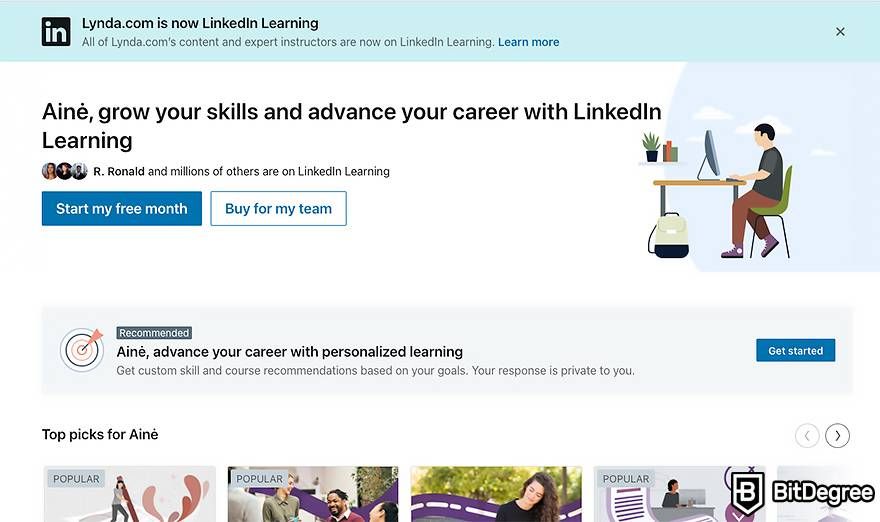
LinkedIn Learning itself is a subsidiary of LinkedIn. The “learning” version of the site is designed to help people learn useful and even essential skills that would help them do better in building their career paths in the current job market.
The website provides courses and learning paths on various topics, starting from business and technology and going all the way up to creative and artistic ones.
Back in 2015, LinkedIn purchased Lynda.com - a MOOC provider with a huge database of courses. All of the content that Lynda possessed (and still does) has been transferred (shared) with LinkedIn Learning. Even though all of the courses and learning paths are still available on Lynda.com, the site itself advises people to go to LinkedIn Learning.
LinkedIn Learning Review: PROS
Now that you have some context, let's focus on trying to answer the question, “Is LinkedIn Learning worth it?” To do that, we'll have to go over the main benefits and drawbacks of the platform. Though, be it a LinkedIn Learning review, or any other, I always prefer to begin with the benefits.
So Easy to Use, You Could Do It Blindfolded
Ease of use is a very important aspect of any website, let alone an online course-providing one. If you come across an MOOC provider online and go to visit its website, you are probably going to judge the entire platform based solemnly on the homepage. This is true both when it comes to design and usability.
And, honestly, that’s fair game - if the front page of a website looks great and feels intuitive to use, chances are that the rest of the site will also be up to par.
Because of these reasons, I have chosen to start the analysis from LinkedIn Learning’s homepage and make my way up from there. That’s the most common method that I follow when writing MOOC reviews, and I have found that it is also one of the most effective ones.
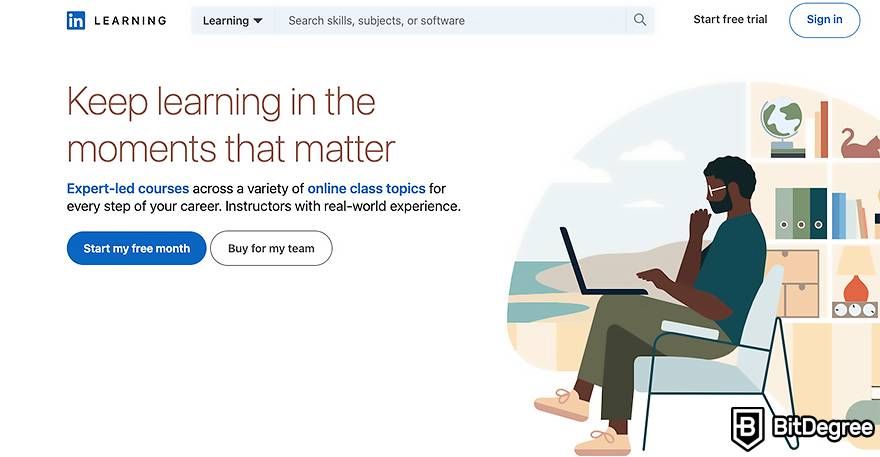
Now, there aren’t many LinkedIn Learning reviews that would talk about the usability of the site, and I can see why as soon as I enter the front page. If you were to imagine an online course-providing website, a pretty generic view that you could visualize would probably be a great representation of the LinkedIn Learning homepage.
While the design is not very exciting, I'll talk a bit more about that later. When it comes to the usage, though, the page works perfectly fine. Since it belongs to LinkedIn (which is a huge and well-known name all by itself), one would probably expect nothing less.

As the site follows a pretty standard layout, everything is where it usually is - learning options on top, featured and recommended courses in the middle, and some self-promo at the bottom of the page. So, before you sign in, you can see which topics and courses are trending at the moment.
Once you do decide to sign in, you'll need a LinkedIn account. Since I already have one, all it took was filling in my account email and password. However, if you don't have a LinkedIn account yet, it might take a bit longer as you'll have to create one first (obviously).
The account creation process itself is quick, but it might take more time if you want to complete your account by filling in information about your education, workplace, interests, and so on. You don't necessarily need to do that, but you do if you want to get custom suggestions.

Now, what you'll see once you sort things out is a page full of various courses. Apart from these courses being grouped based on their length, popularity, topic, or release date, there's not much else on the homepage. So, you can either choose a course from here, search for something specific using the search bar, or explore the categorization system.
I'll talk more about both the categorization system and the courses itself a bit later. Right now, just note that the website is definitely easy to use and navigate around. If you’ve ever used a service similar to that of LinkedIn Learning, everything on the platform is going to be quite intuitive since it doesn't really stray away from the norm.
Now, we’ve established that the website is easy to use. That’s a great start! However, the true test of a MOOC-providing platform comes when you take a look at its content quality. Let’s see what user LinkedIn Learning reviews have to say about that.
Thousands of Decent Quality Courses
There’s an old saying that goes something like this - “content is king”. This couldn’t be more true than when we’re talking about online course providers. Courses are the only reason why people come to these sites - it’s only logical that the company would have the best and strictest quality control system in place.
And it doesn't even matter what those courses are, either - programming (general), HTML, Python, writing, arts, or whatever else. The same standard of quality should apply to all of them!
According to a lot of LinkedIn Learning reviews, however, it seems that the platform can’t really say that it has the best courses out there. On the contrary, students claim that the courses are actually pretty mediocre, on top of other concerns that they face.
First of all, there’s a significant amount of LinkedIn Learning reviews that are disappointed with the lack of more advanced courses on the site. Students claim that beginner-oriented courses dominate the platform, and it’s very difficult to find something that’s a bit more advanced.
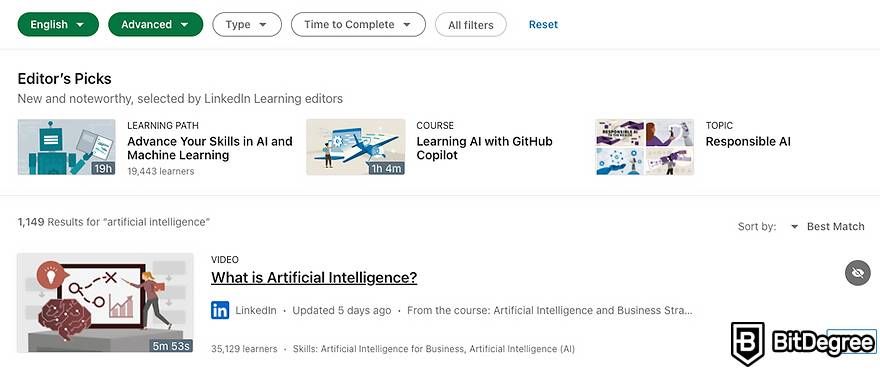
I was interested to see that for myself, so I searched for learning material on artificial intelligence (after all, it's the talk of the town at the moment[2]). I got over 6,000 results, featuring various videos, courses, and learning paths. Then, I filtered these results to display only advanced-level content, and it went down to a little over 1,000 results.
Now, 1,000 definitely is a lot of advanced learning material, which would take quite a lot of time to go through. However, it's just around 16% of search results, which means that beginner- and intermediate-level content indeed dominates the platform.
On the other hand, it's not actually a bad thing, because the majority of those who use learning platforms are probably searching for beginner or intermediate content either way. If you're up for more challenges, though, check out courses on DataCamp or Udemy.
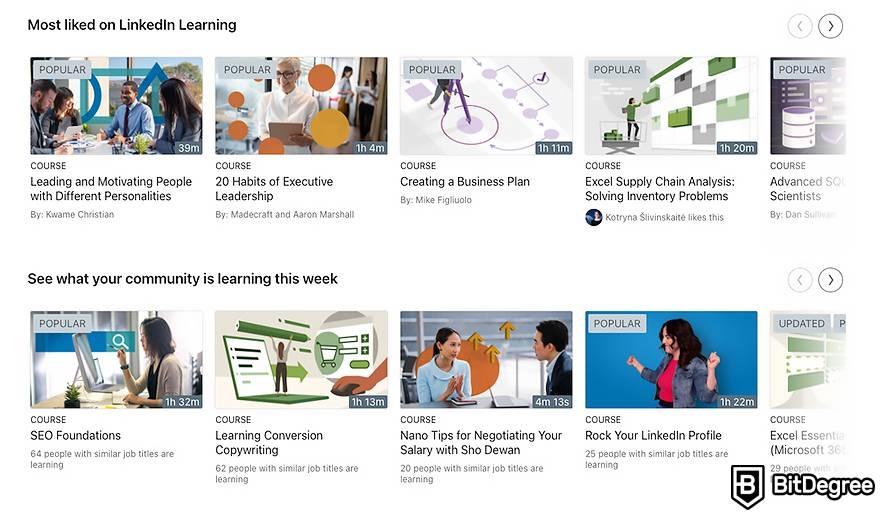
Moving on, when it comes to content quality, other LinkedIn Learning reviews also state that many of the courses are a bit boring and PowerPoint-presentation-like. They claim that the videos feel staged and lack personality because they look like corporate boardroom presentations where the speaker just wrote a speech and learned it by heart.
Well, I definitely didn't watch all the courses on LinkedIn Learning, but the ones I did watch seemed to be pretty interesting and not emotionless. Sure, the speakers have probably prepared their speeches (after all, not everyone is the master of speaking on the spot), but it didn't seem like they were just giving that learned-by-heart presentation.
I did watch the courses on the more creative side, though, like learning about personal branding, how to write with flair, or how to use Canva. Maybe the courses that are more technical are, well... more technical and boring?
Nevertheless, I believe that with over 21,500 courses available, there's a high chance that you'll find both boring and very interesting ones (it also depends on how one defines boring).

By the way, I'll talk a bit more about my learning experience with one of the aforementioned courses later in this review.
Lastly, it's worth mentioning that quite a few people believe that you could easily find other, free online course providers that would offer similar quality at no cost. I will not argue with that.
However, what I can say is that LinkedIn Learning has a variety of courses - some might be very interesting, others not so much, but, at the end of the day, it all depends on your own preferences.
Videos, Courses, Learning Paths, and More
When it comes to e-learning platforms, features are a tricky topic. It’s usually one of the two - either a site has a lot of different features (almost too much to keep up with), or it lacks them altogether.
It is advised to search for the middle ground, however. This is because interesting and original features can really help a site attract new customers and maintain the interest of the old ones. This isn’t exclusive to online course providers - many different businesses think the same.
The three big sections that LinkedIn Learning offers to the students are called “Higher Education,” “Government,” and “Business”. You could also add a fourth one - that would be the general student population; people who have come to the site with a single topic in mind, looking for a specific type of a course.
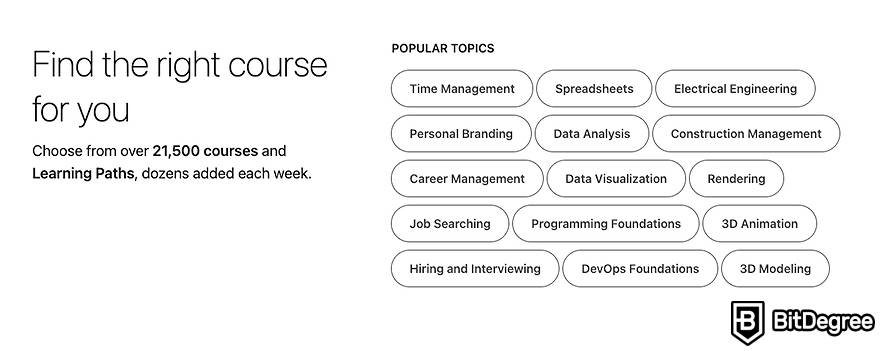
Each of the above-mentioned sections deals with very different subject matters. Higher education is aimed at academia, while the government and business sections offer advanced learning strategies to different kinds of employees (and employers).
When it comes to the format of learning material you can access, there are four main types:
- Videos
- Audios
- Courses
- Learning Paths
A video is the shortest bit of learning material you can use. Each video focuses on just one skill or idea. Even though they're usually part of bigger courses, you can watch them on their own. This is handy if you only need to learn something specific, like, for example, how to remove an image background in Photoshop.
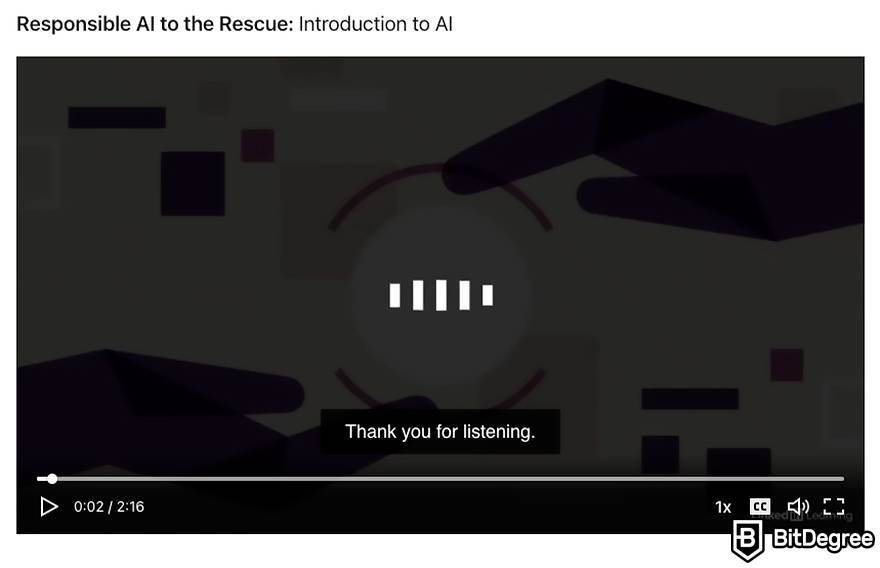
An audio-type lesson is pretty much like a video, apart from the fact that it has no visualizations. So, basically, it's like a podcast or an audiobook. Audio lessons are also usually a part of a course, but you can listen to them separately nonetheless.
Now, a course is a series of videos or audios about one specific subject. The same expert or a group of experts create and present each video in a course. At first, I thought some courses might just be a bunch of videos on a similar topic, but that's not true. Every video in LinkedIn Learning courses is made to fit into the course's learning direction.
Moving further, learning paths are carefully chosen sets of courses put together by experts. They're designed to guide learners toward achieving very precise career-related objectives. Learning paths could even be used if you want to steer your career in a completely different direction.
Of course, if you're a baker, you will not become a surgeon by watching some educational videos; I'm not talking about such drastic changes.
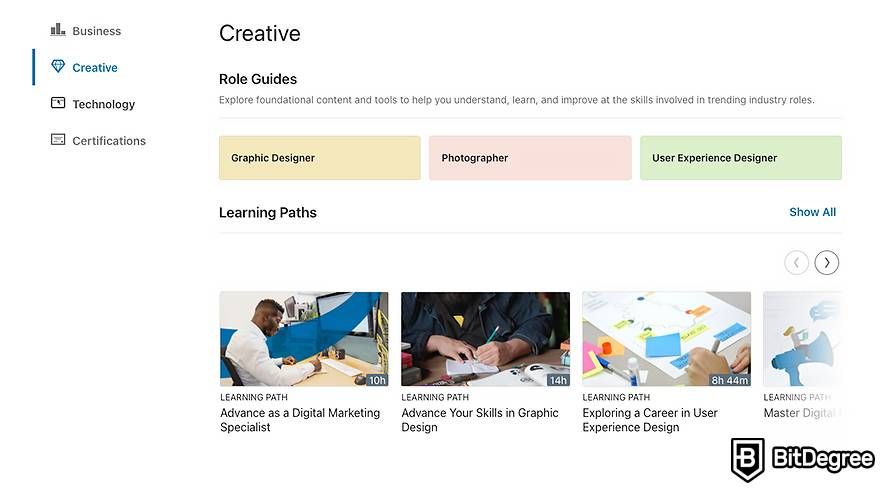
It's also worth noting that LinkedIn Learning has a pretty nice categorization system I briefly mentioned before. It has three main topics – business, creative, and technology. When you go into one of these, you are then provided with role guides, learning paths, and the main subtopics of the topic in question.
Role guides seem especially useful as they direct you toward all the fundamental content and tools for skill improvement based on your desired career.
Additionally, LinkedIn Learning also offers students a month of free trial, offline course viewing options, LinkedIn Learning-exclusive certification, quizzes, recommendations, and so on. None of these features are unique to the site, but it’s still nice that they’re there.

Did you know?
All Online Learning Platforms may look similar to you but they're NOT all the same!
LinkedIn Learning Review: CONS
Okay, now that we've talked about the main pros of LinkedIn Learning, we have to acknowledge its cons. It wouldn't be a complete LinkedIn Learning review without it, now would it?
I know I've already touched upon a few drawbacks that other people mention in their LinkedIn Learning reviews when I covered the benefits of the platform. However, the main cons that are actually worth pointing out, in my opinion, are the lack of accreditation when it comes to certificates and bland website design.
Certificates Without Accreditation
As a lot of LinkedIn Learning reviews point out, the platform does lack a huge feature that some other online learning platforms offer - accredited certification. You can, indeed, display a type of a “certificate” on your LinkedIn profile once you’ve finished a course or a learning path, but that’s quite far from what people who are complaining have in mind.
You see, while LinkedIn Learning provides shareable certificates, which showcase that you've gained certain knowledge on some skill, they are not endorsed or recognized by third parties.

So, if you go to a job interview that requires you to have a legit Photoshop certificate, for example, a LinkedIn Learning certificate will probably not suffice (unless your potential employer thinks otherwise).
Perhaps this wouldn’t be as big of an issue if LinkedIn Learning wasn’t a paid service provider. According to LinkedIn Learning reviews, some other similar platforms offer certification at a similar price.
Website Design as Exciting as Beige Paint
Now, the visual side of the website is, well… Honestly, it’s almost non-existent. It’s evident that the site aims to look professional, but all that I see is a cold and bleak design with little creativity put into it. This is also something that a couple of other user LinkedIn Learning reviews picked up on.
I do, however, acknowledge that visuals are just that - they don’t really get in the way of the overall learning experience (especially if the platform has everything else in order). Besides, the page does look professional and avoids some of the industry cliches that are prominent in some other websites of a similar concept, but it still feels very cold.
Put simply, LinkedIn Learning’s front page is devoid of a personal touch, and that’s honestly a sad thing!
Multiple Pricing Options
If you were to take a look at the majority of LinkedIn Learning reviews found online, you would probably notice that people aren’t all that happy with how the site deals with their pricing.
There are two major complaints that can be extracted from these LinkedIn Learning reviews. First of all, students say that the fact that you have to register your credit card and buy a subscription to get a free trial is a bit… well, annoying. Though you do get a 30-day free trial, which is pretty generous.
However, this is the smaller problem - the main issue comes up with the pricing plans themselves.
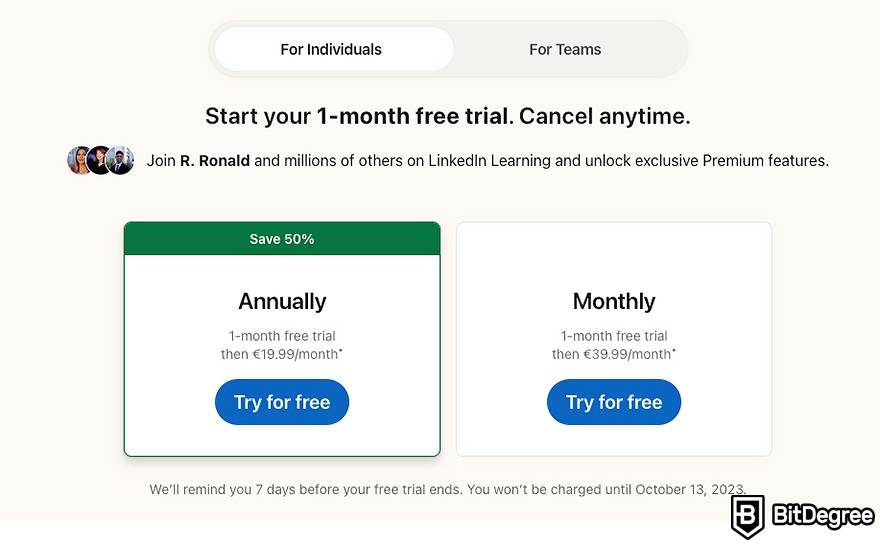
A monthly subscription to LinkedIn Learning costs $19.99 if billed yearly or $39.99 if billed monthly. With it, you get all of what the platform offers - over 21,500 courses and learning paths, offline viewing options, tasks, recommendations, mobile support, etc. Now, you might be thinking - that’s pretty good! And, honestly, it does seem that way. So, what’s the problem?
Well, the main problem that a lot of LinkedIn Learning reviews point out is the exact same one we’ve just discussed - the lack of accredited certification. Nevertheless, if you're not looking for certification specifically, and are just interested in learning or improving some skills, it's still a bargain that's more on the expensive side compared to some other learning platforms.
Though, what definitely is a plus is that there are no hidden fees. If you subscribe to LinkedIn Learning, you'll get access to all of its learning material, no questions asked. So, there will be no "if you want to watch the full course, pay an extra $399,99" nonsense.
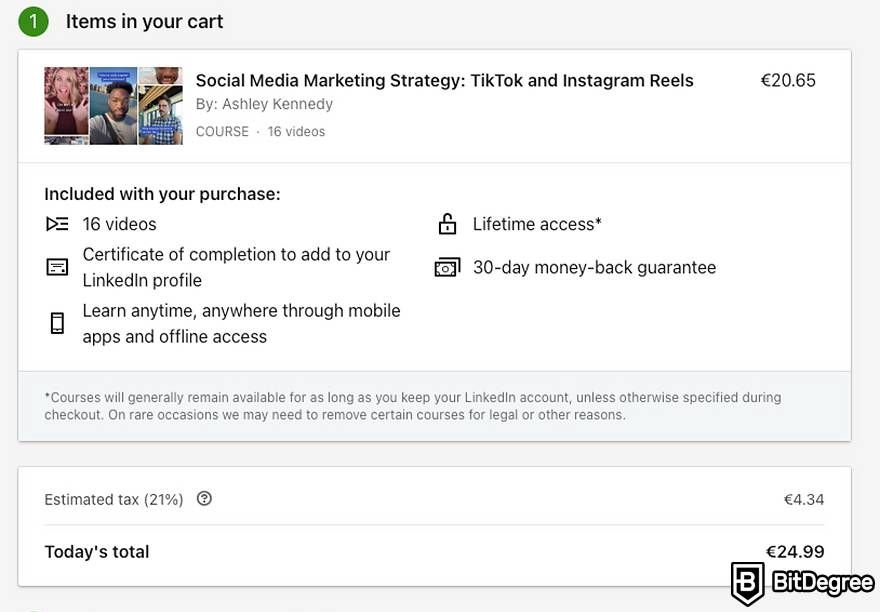
Now, are there any other payment options? Well, while not all LinkedIn Learning reviews mention this, you don't actually have to subscribe to the platform, you can just buy a certain course you're interested in. However, I definitely wouldn't recommend this because one course usually costs around the same as the whole subscription plan.
Besides that, there is one other option – you can subscribe to LinkedIn Premium. Yes, I'm talking about LinkedIn itself, not the learning platform. It has four plans (Career, Business, Sales Navigator Core, and Recruiter Lite), all of which provide full access to LinkedIn Learning courses.
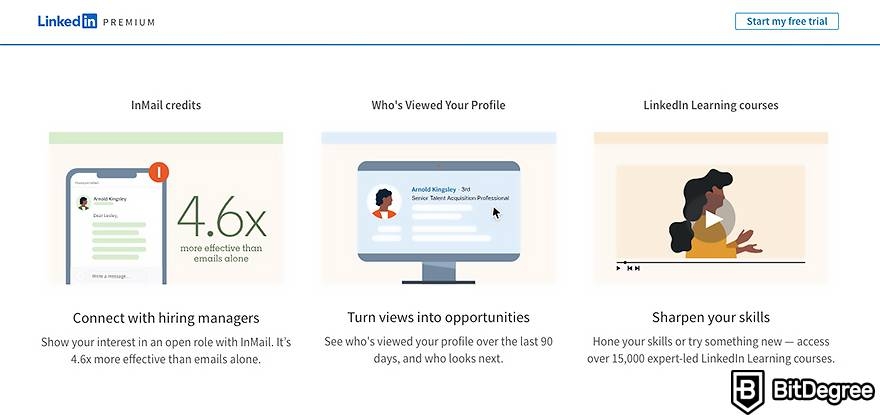
If you go with the Career plan, for example, you get access to LinkedIn Learning, exclusive insights on your LinkedIn profile, and some useful features when it comes to finding and contacting people, all for $39.99/month. Now that's a pretty decent bargain, if you're an active user of LinkedIn (or plan to be).
My Learning Experience on LinkedIn Learning
Now that you have a full picture of the main points discussed in various LinkedIn Learning reviews, I want to talk more about my personal learning experience on LinkedIn Learning.

First things first, what I immediately noticed and appreciated after signing in with my LinkedIn account was the personalized suggestions I received based on my career. They not only provided some of the top courses that might be of interest to me, but also determined what kind of skills might be useful to improve if I want to advance my career. That's pretty nice, right?
Now, what about the look and feel of the course pages themselves? Are there any glitches, bugs, loading time difficulties, etc.? Let's take the “Writing with Flair: How to Become an Exceptional Writer” course as an example.

What I noticed is that introductory course pages are pretty standard as far as online course providers go. I did like the instructor info section - you can actually find out quite a lot about the person who will be teaching you from that part of the course page. Other than that, you have pretty standard course descriptions, lecture lists, lesson previews, and so on.
Once you go inside the course, you'll notice that the learning dashboard is also pretty similar to those of other learning platforms – you have the whole course with its chapters and subchapters displayed on your left and the currently playing video on your right. Then, below the video, you have Overview, Q&A, Notebook, and Transcript sections.

When it comes to the video player, everything seems to be okay. I didn't really experience any glitches or loading problems, everything went smoothly. The only thing I didn't really enjoy is the auto-play function, which prompted the video to play immediately after I opened the course.
I hate when this happens, what if I was sitting in a café and my headphones decided to give up on me while my volume was spiked to the maximum?
Speaking of the tools below the video, I really liked both the Q&A and Notebook sections. The Q&A section allows you to ask any questions about the video (or leave some very interesting insights, if you will) and get an answer from the author of the course or other LinkedIn Learning users.
The Notebook section allows you to leave bookmark-like notes throughout the video, which is very useful.

All in all, I'd say that the learning experience on LinkedIn Learning is pretty smooth. Now, summing up all of the LinkedIn Learning reviews that we’ve covered together and my insights, let’s try to answer the question, “Is LinkedIn Learning worth it?”.
In general, it would seem that students are quite split when it comes to the learning experience on LinkedIn Learning. Some of them say that they’ve enjoyed the courses, others - that they were somewhat disappointed. However, the majority of users agree that the platform truly is one of the better options when it comes to online learning.
My personal opinion is that the platform is very simple to use and pretty cool if you are an active LinkedIn user, especially if you already have a LinkedIn Premium subscription. Still, whether we take the pricing or the design - there’s always room for improvement!

- Easy to use with a learn-by-doing approach
- Offers quality content
- Gamified in-browser coding experience
- Free certificates of completion
- Focused on data science skills
- Flexible learning timetable

- High-quality courses
- Nanodegree programs
- Student Career services
- Nanodegree programs
- Suitable for enterprises
- Paid certificates of completion

- A wide range of learning programs
- University-level courses
- Easy to navigate
- University-level courses
- Suitable for enterprises
- Verified certificates of completion
Conclusions
So, with that, we have reached the end of my LinkedIn Learning review. I hope that the information presented in this article was useful for you! If you do decide to try LinkedIn Learning out, do keep in mind that there’s a mandatory registration for that free month!
All of that being said, though, LinkedIn Learning is a decent choice for anyone who wants to improve their skills in a particular area. It's even better if you're a complete newbie, and want to find a great place where to start learning! For an even more enriched experience, though, make sure to visit DataCamp or Udemy - perhaps your ideal course is waiting for you there?
Whatever you might decide to do, I wish you the best of luck!
Scientific References
1. W. Al-Rahmi, A. Aldraiweesh, N. Yahaya, et al.: 'Massive Open Online Courses (MOOCs): Data on Higher Education';
2. H. Crompton, D. Burke: 'Artificial Intelligence in Higher Education: The State of the Field'.


